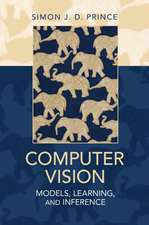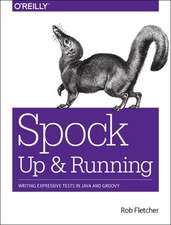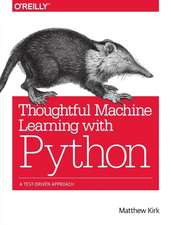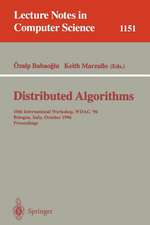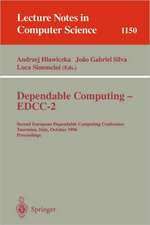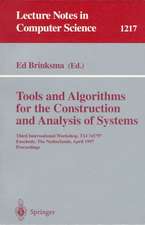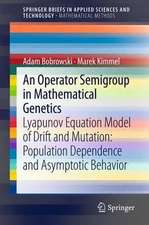Bioinformatics
Autor Andrzej Polanski, Marek Kimmelen Limba Engleză Hardback – 19 apr 2007
In this comprehensive textbook, Polanski and Kimmel present mathematical models in bioinformatics and they describe the biological problems that inspire the computer science tools used to handle the enormous data sets involved. The first part of the book covers the mathematical and computational methods, while the practical applications are presented in the second part. The mathematical presentation is descriptive and avoids unnecessary formalism, and yet remains clear and precise. Emphasis is laid on motivation through biological problems and cross applications. Each of the four chapters in the first part is accompanied by exercises and problems to support an understanding of the techniques presented. Each of the six chapters of the second part is devoted to some specific application domain: sequence alignment, molecular phylogenetics and coalescence theory, genomics, proteomics, RNA, and DNA microarrays. Each chapter concludes with a problems and projects section, to deepen the reader's understanding and to allow for the design of derived methods. Many of the projects involve publicly available software and/or Web-based bioinformatics depositories. Finally, the book closes with a thorough bibliography, reaching from classic research results to very recent findings, providing many pointers for future research.Overall, this volume is ideally suited for a senior undergraduate or graduate course on bioinformatics, with a strong focuson its mathematical and computer science background.
| Toate formatele și edițiile | Preț | Express |
|---|---|---|
| Paperback (1) | 337.32 lei 43-57 zile | |
| Springer Berlin, Heidelberg – 12 feb 2010 | 337.32 lei 43-57 zile | |
| Hardback (1) | 345.91 lei 43-57 zile | |
| Springer Berlin, Heidelberg – 19 apr 2007 | 345.91 lei 43-57 zile |
Preț: 345.91 lei
Preț vechi: 432.39 lei
-20% Nou
Puncte Express: 519
Preț estimativ în valută:
66.21€ • 71.94$ • 55.65£
66.21€ • 71.94$ • 55.65£
Carte tipărită la comandă
Livrare economică 21 aprilie-05 mai
Preluare comenzi: 021 569.72.76
Specificații
ISBN-13: 9783540241669
ISBN-10: 3540241663
Pagini: 396
Ilustrații: XVII, 376 p.
Dimensiuni: 155 x 235 x 27 mm
Greutate: 0.79 kg
Ediția:2007
Editura: Springer Berlin, Heidelberg
Colecția Springer
Locul publicării:Berlin, Heidelberg, Germany
ISBN-10: 3540241663
Pagini: 396
Ilustrații: XVII, 376 p.
Dimensiuni: 155 x 235 x 27 mm
Greutate: 0.79 kg
Ediția:2007
Editura: Springer Berlin, Heidelberg
Colecția Springer
Locul publicării:Berlin, Heidelberg, Germany
Public țintă
GraduateCuprins
Mathematical and Computational Methods.- Probability and Statistics.- Computer Science Algorithms.- Pattern Analysis.- Optimization.- Applications.- Sequence Alignment.- Molecular Phylogenetics.- Genomics.- Proteomics.- RNA.- DNA Microarrays.- Bioinformatic Databases and Bioinformatic Internet Resources.
Recenzii
From the reviews:
"The authors present mathematical models in bioinformatics and describe the biological problems that inspire the computer science tools used to handle the enormous data sets involved. … Who is it for? Graduates and researchers who want more than just another guide on how to use databases. Presentation Clear and logical. Would you recommend it? Yes, if you are interested in the statistical and mathematical underbelly of bioinformatics." (Times Higher Education, May, 2008)
"The strength of the book is its thorough survey of bioinformatics topics. … Its structure–two parts (foundations and applications), well-classified problem areas, and a gradual approach for problem framing and solving- make it invaluable for computer scientists learning bioinformatics, or biologists applying computational methods to their fields. The book is suitable for graduate students and professionals, and can serve as a reference for state-of-the-art issues and solutions." (Cherif Keramane, ACM Computing Reviews, September, 2008)
"In this comprehensive textbook, the authors present mathematical models in bioinformatics and describe the biological problems that inspire the computer science tools used to handle the enormous data sets involved. … the book closes with a thorough bibliography, reaching from classical research results to very recent findings, providing many pointers for future research. This volume is ideally suited for a senior undergraduate or graduate course on bioinformatics, with a strong focus on its mathematical and computer science background." (T. Postelnicu, Zentrablatt MATH, Vol. 1153, 2009)
"The authors present mathematical models in bioinformatics and describe the biological problems that inspire the computer science tools used to handle the enormous data sets involved. … Who is it for? Graduates and researchers who want more than just another guide on how to use databases. Presentation Clear and logical. Would you recommend it? Yes, if you are interested in the statistical and mathematical underbelly of bioinformatics." (Times Higher Education, May, 2008)
"The strength of the book is its thorough survey of bioinformatics topics. … Its structure–two parts (foundations and applications), well-classified problem areas, and a gradual approach for problem framing and solving- make it invaluable for computer scientists learning bioinformatics, or biologists applying computational methods to their fields. The book is suitable for graduate students and professionals, and can serve as a reference for state-of-the-art issues and solutions." (Cherif Keramane, ACM Computing Reviews, September, 2008)
"In this comprehensive textbook, the authors present mathematical models in bioinformatics and describe the biological problems that inspire the computer science tools used to handle the enormous data sets involved. … the book closes with a thorough bibliography, reaching from classical research results to very recent findings, providing many pointers for future research. This volume is ideally suited for a senior undergraduate or graduate course on bioinformatics, with a strong focus on its mathematical and computer science background." (T. Postelnicu, Zentrablatt MATH, Vol. 1153, 2009)
Notă biografică
Andrzej Polanski is Professor at the Silesian University of Technology. Prior to this, he worked as a Post Doctoral Fellow at the University of Texas, Human Genetics Center, Houston USA (1996-1997) ans as a Visiting Professor at Rice University, Houston USA (2001-2003). His research interests are in bioinformatics, biomedical modeling and control, modern control and optimization theory.
Marek Kimmel, Ph.D., is a Professor of Statistics at Rice University in Houston, TX, Professor in Department of Automatic Control, Silesian University of Technology in Gliwice, Poland, Professor of Biostatistics and Applied Mathematics (adj.) at M.D. Anderson Cancer Center in Houston, and a Professor of Biometry (adj.) at the School of Public Health of the University of Texas in Houston. He is heading the Rice Bioinformatics Group as well as the doctoral program in Statistical Genetics and Bioinformatics. Dr. Kimmel is a Fellow of the American Statistical Association. His principal interests are stochastic modeling of human disease (in particular lung cancer progression and screening), statistical and population genetics, biostatistics and bioinformatics.
Marek Kimmel, Ph.D., is a Professor of Statistics at Rice University in Houston, TX, Professor in Department of Automatic Control, Silesian University of Technology in Gliwice, Poland, Professor of Biostatistics and Applied Mathematics (adj.) at M.D. Anderson Cancer Center in Houston, and a Professor of Biometry (adj.) at the School of Public Health of the University of Texas in Houston. He is heading the Rice Bioinformatics Group as well as the doctoral program in Statistical Genetics and Bioinformatics. Dr. Kimmel is a Fellow of the American Statistical Association. His principal interests are stochastic modeling of human disease (in particular lung cancer progression and screening), statistical and population genetics, biostatistics and bioinformatics.
Textul de pe ultima copertă
Bioinformatics as a discipline arose out of the need to introduce order into the massive data sets produced by the new technologies of molecular biology: large-scale DNA sequencing, measurements of RNA concentrations in multiple gene expression arrays, and new profiling techniques in proteomics. As such, bioinformatics integrates a number of traditional quantitative sciences such as mathematics, statistics, computer science and cybernetics with biological sciences such as genetics, genomics, proteomics and molecular evolution.
In this comprehensive textbook, Polanski and Kimmel present mathematical models in bioinformatics and they describe the biological problems that inspire the computer science tools used to handle the enormous data sets involved. The first part of the book covers the mathematical and computational methods, while the practical applications are presented in the second part. The mathematical presentation is descriptive and avoids unnecessary formalism, and yet remains clear and precise. Emphasis is laid on motivation through biological problems and cross applications. Each of the four chapters in the first part is accompanied by exercises and problems to support an understanding of the techniques presented. Each of the six chapters of the second part is devoted to some specific application domain: sequence alignment, molecular phylogenetics and coalescence theory, genomics, proteomics, RNA, and DNA microarrays. Each chapter concludes with a problems and projects section, to deepen the reader's understanding and to allow for the design of derived methods. Many of the projects involve publicly available software and/or Web-based bioinformatics depositories. Finally, the book closes with a thorough bibliography, reaching from classic research results to very recent findings, providing many pointers for future research.Overall, this volume is ideally suited for a senior undergraduate or graduate course on bioinformatics, with a strong focuson its mathematical and computer science background.
In this comprehensive textbook, Polanski and Kimmel present mathematical models in bioinformatics and they describe the biological problems that inspire the computer science tools used to handle the enormous data sets involved. The first part of the book covers the mathematical and computational methods, while the practical applications are presented in the second part. The mathematical presentation is descriptive and avoids unnecessary formalism, and yet remains clear and precise. Emphasis is laid on motivation through biological problems and cross applications. Each of the four chapters in the first part is accompanied by exercises and problems to support an understanding of the techniques presented. Each of the six chapters of the second part is devoted to some specific application domain: sequence alignment, molecular phylogenetics and coalescence theory, genomics, proteomics, RNA, and DNA microarrays. Each chapter concludes with a problems and projects section, to deepen the reader's understanding and to allow for the design of derived methods. Many of the projects involve publicly available software and/or Web-based bioinformatics depositories. Finally, the book closes with a thorough bibliography, reaching from classic research results to very recent findings, providing many pointers for future research.Overall, this volume is ideally suited for a senior undergraduate or graduate course on bioinformatics, with a strong focuson its mathematical and computer science background.
Caracteristici
Includes supplementary material: sn.pub/extras


